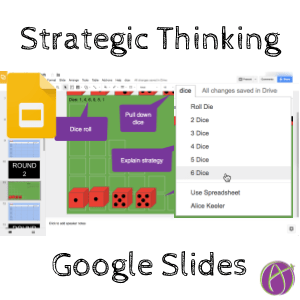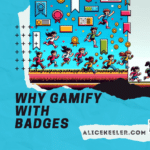This post has been updated.
Play Farkle in Google Slides
Previously I had blogged on playing Farkle and provided a template in Google Slides and Google Sheets. The Google Sheets spreadsheet had a menu I coded to allow students to roll dice within the spreadsheet. I think using actual dice is better but when we do not have access to dice, it’s a decent alternative. Thanks to new capabilities to use Google Apps Script in Google Slides I have been able to add dice rolling in the Google Slides.
Template
Farkle Dice
In a nutshell, Farkle is a dice game with 10 rounds to score the most points. You need 6 dice. Roll all 6. A 1 is worth 100 points and a 5 is worth 50. 3 of a kind or a straight will earn you more points. If you roll and have no point scoring dice you Farkle and have a score of zero for the round.
Why Farkle
I like to use Farkle as a model for what strategic thinking (DOK 3) looks like. My lesson plan is to greet students at the door with paper directions (or direct them to Google Classroom for the linked Google Doc with directions) of how to play Farkle. The directions are intentionally not a guidebook. It’s simply one sheet, front and back, and includes a scoring sheet. Greet students at the door and ask them to work collaboratively to play Farkle and figure it out. The conversations students naturally engage in when trying to figure out how to play are great. They are asking questions of each other, trying something, and debating the rules. I go around and answer questions, making clarifications to the small groups. After a bit, I pull everyone’s attention and we do a round together. This is an opportunity to further clarify some of the game rules.

I may roll a 1, 1, 5, 5, 4, and 6. I have different choices. This is 300 points so I could take my 300 points and stop. I would ask for a show of hands, who would do this option. There are 2 junk dice. Who would roll the 2 junk dice to try for additional points? “Why would you be willing to risk your 300 points?” I might ask one of the students who indicates they would take this option. “Who would only keep one of the 1’s and roll the other 5 dice?” There are at least 3 legitimate choices for what to do next. This is where the students can discuss their strategies and reasoning. I love that not everyone would do it the same way or for the same reasons.
Return the students to keep playing encouraging them to strategize with each other, defend their choices, and continue to answer questions. I try to encourage students to make different choices “are you sure, why wouldn’t you keep both the 1’s?” Challenge their thinking and have them defend their decision.
5 E’s: Engage, Explore, Explain, Extend, Evaluate
Playing Farkle with students can model the 5 E’s lesson plan. Start a lesson with engaging students (give them dice). Then the students explore. Explain comes THIRD! Rather than holding all the students hostage as I go through all the Farkle rules and showing them how I play and giving them my strategies, instead we start with seeing what students can figure out. When I do get to the explain stage I do not have to explain every piece, just the parts that the students were stuck on. Less words, more time students doing things.
In Slides Dice
If you want to use the dice I coded into the Google Slides, look for the menu next to the Help menu.

Note: the students will have to authorize the script to roll the dice. The app does not collect any student data and only gives the students access to their own Google Slides. I coded this myself, look under the Tools menu and go to “Script editor” to read the code to see there is no malicious code.
Choosing 6 dice from the menu will “roll 6 dice,” display the results in a pop up, and then add a textbox to the slide with the roll.
Point Dice
From the top of the slide the student can drag down the dice that represent the points they want to keep.
Strategy Box
Something I want to get students into the habit of is to explain their thinking, what is their strategy. There is a placeholder for the students to write their reasoning for how they play. This is a fun low risk way to introduce students to the idea of being in the habit of explaining their decisions.
Duplicate
After each dice roll and strategy explanation, the student would duplicate the slide on the left side in the filmstrip. The student can then use the dice menu again. If they only had one point die they pulled aside they would choose to roll the 5 remaining dice. If they had a 3 of a kind then the student only would roll 3 dice and thus choose that from the dice menu.
Use Slides for Other Things
This is an example of how to use Slides to demonstrate the process and thinking, it can be applied to a lot of different contexts besides Farkle. The Farkle helps them get used to the method of using Google Slides, duplicating each step, and adding a textbox to explain their strategy or thinking.







